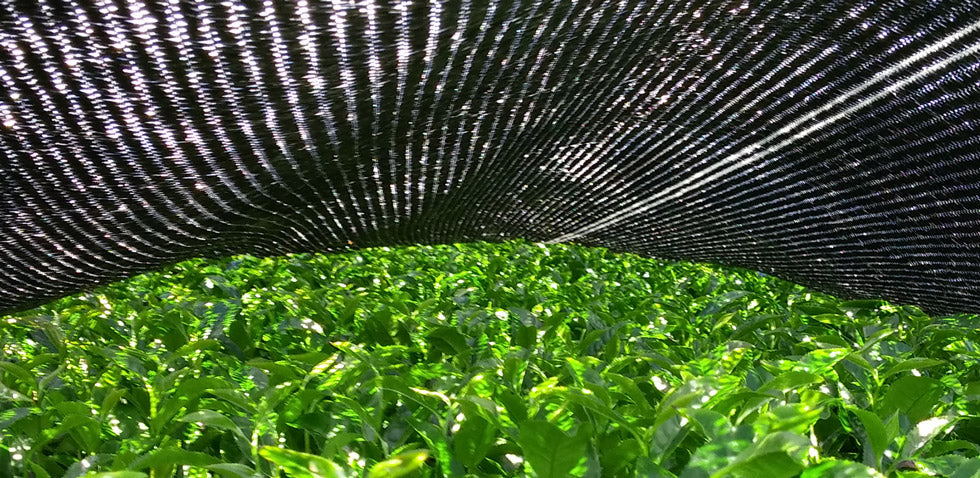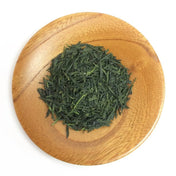As the name suggests in Japanese, “kabusecha” which means covered tea is grown by covering the tea leaves with a cloth called kanreisha before they are harvested. This shade growing cultivation method is called “hifuku saibai” (Japanese: 被覆栽培), and is also utilized for making gyokuro and tencha (tea that is the raw material for matcha), also teas made through shade growing cultivation. This shading blocks a certain amount of sunlight from reaching new tea leaves for a certain period of time, which changes the tea leaf.
Previously, I wrote a rather in-depth article with respect to shade growing cultivation techniques so I will not go super in depth about this here. However, to provide recap on what happens when the tea leaves are shaded (recall, photosynthesis from biology class?):
Tea leaves contain theanine, a type of amino acid, which is made in the roots. Theanine accounts for approximately 50% of all amino acids in Japanese tea, and is the component that contributes to its umami flavor. So, the more amino acids (including theanine) the tea contains, the stronger its flavor and sweetness.
It is known that theanine is converted into catechin when tea leaves are exposed to sunlight. Catechin is the component that gives Japanese tea its bitterness and astringency, so when the tea leaves are exposed to sunlight and theanine changes into catechin, the tea becomes characterized by bitterness and astringency (shibumi), rather than with umami and sweetness.
This is why shaded teas like gyokuro and kabusecha are higher in umami. By blocking the sunlight, it becomes more difficult for theanine in tea leaves to convert into catechin. So more theanine and less catechin, a tea with stronger umami and sweetness, and less astringency and bitterness.
The general covering period for kabusecha varies depending on the region and tea plantation, but it is approximately 1 week to 10 days. As I will discuss in detail later, the longer the covering period, the more the quality of the tea will be similar to gyokuro, and the shorter the covering period, the quality of the tea will be more similar to sencha.
Additionally, shade growing cultivation has a positive influence not only on the taste but also on the color of the tea leaves. Plants generate energy through photosynthesis, and chlorophyll plays the essential role of absorbing light energy during this process. Tea leaves are green because they contain chlorophyll.
Under cover cultivation, sunlight is blocked, so the tea leaves increase their chlorophyll production in an effort to take in as much of the precious sunlight as possible. Accordingly, the leaves of kabusecha are bright green with a slight bluish tint.
Earlier we mentioned that in addition to kabusecha, gyokuro and tencha are also grown using covered cultivation. So you may be wondering, what the differences are between these three teas. In certain situations, the covering method will vary, but it is difficult to generalize as there are large differences depending on shading techniques, the region and the tea farm. The more common difference is the length of the covering period.
To recap, kabusecha is typically covered for seven to ten days. On the other hand, gyokuro is covered for around 20 days, and tencha is often covered for an additional five days. That being said, with respect to the order of the length of the covering period, it goes: kabusecha < gyokuro < tencha.
The longer the tea is shaded from sunlight, the less theanine is converted into catechins, so gyokuro and tencha are usually teas with stronger umami and sweetness, in comparison to kabusecha. This doesn’t mean however that kabusecha is inferior, or less delicious.
There are many varieties of kabusecha, from those with a relatively short covering period and a taste similar to sencha, to those with a longer covering period and a quality similar to gyokuro. One could say it's a tea that takes the best of both worlds, an in-between tea of gyokuro and sencha.
Ise, Mie Prefecture, the region famous for kabusecha
According to the Ministry of Agriculture, Forestry and Fisheries report, kabusecha accounted for approximately 2.8% of Japanese tea production in 2022. So in general, it is a less produced type of lightly shaded tea. Geographically, it is commonly produced from the Kanto to Kyushu areas in Japan, but Mie Prefecture accounts for over 60% of the total kabusecha production. In fact, Mie Prefecture ranked third in the production of aracha (crude tea), the primary processed product of tea, after Shizuoka and Kagoshima in the year 2023.
Although Shizuoka and Kagoshima Prefectures are quite famous for their tea, one may be surprised to hear Mie Prefecture being ranked third for the production of crude tea. Still, the history of tea in this prefecture is quite old, with the earliest records dating back to the beginning of 900 AD in Ichijoji, Mizusawa-cho, Yokkaichi City.
The history of Ise tea is deep, as Myoe Shonin, who popularized tea cultivation throughout the country during the Kamakura period, planted tea seeds in Ise Kawakami. Subsequently, towards the end of the Edo period, Norihiro Nakagawa, the chief priest of Joganji Temple in Mizusawa Town, brought tea seeds back from Uji and spread tea cultivation. This led to the development of the tea industry in this region.
Today, tea is actively produced in the Northwest areas, centered around Yokkaichi City and Suzuka City, and the Southwest areas, centered on Matsusaka City, and is famously known for the Isecha (Ise tea) brand. In particular, the Northwest region is quite vibrant as the major production area for kabusecha, and tea produced in Suizawa, Yokkaichi City is a key representative type of kabusecha. Hence, since the main kabusecha production area is Mie Prefecture in the west, lightly-shaded tea is geographically distributed in western Japan, including the Kansai region, and it is rare to find it towards eastern Japan, such as the Kanto region.
This is also reflected in the kabusecha (shaded green tea) collection on Yunomi. To wrap up this article on kabusecha, below, are some of the tea farmers that specialize in this tea (i.e., focusing most of their tea work in the production of kabusecha):
Tomizawa Tea Garden - Kumamoto Prefecture
Located in the Kamimashiki District of Kumamoto Prefecture, the Tomizawa family has been manufacturing and selling green tea for over 85 years. Their delicious “kabusecha'' is grown with great care using traditional techniques that have been cultivated for many years, and delivered directly from the farm in the great nature of Kumamoto. Yunomi tea merchant Ian Chun just recently visited them!
Tea farmer Mashiki Kumamoto was affected by the Kumamoto Earthquake, which happened in April in the year 2016. Tomizawa Tea Garden was also affected by their earthquake, losing their tea shop. However, they used this opportunity to rebuild their shop in 2018, calling it the Greentea.Lab.

Marushige Shimizu Tea Factory - Mie Prefecture
The Shimizu family operates an award winning tea farm based in the village of Suizawa in Yokkaichi City, Mie Prefecture (mentioned above, as a major kabusecha producing region). They are a small-scale farm spanning 10 hectares with a total production of about 600 kilograms. They and 9 other commercial farms in the village specialize in kabusecha production. They also run a welcoming and child-friendly "kabusecha cafe" in a traditional Japanese house ( kominka) built approximately 70 years ago.
Sueyoshi Tea Atelier - Kagoshima Prefecture

A tea farmer that I have both interviewed and visited last year (2023), Mataki Tatefumi is currently keeping busy both with the shincha season and caring for his newborn baby. During our interview last year, he shared that one of the secrets to Sueyoshi Tea Atelier's delicious kabusecha lies in the longer than normal shading period of 12 days to 2 weeks (longer than the typical 1week to 10 days). The longer shading period was a decision they made due to feedback from their customers.
Well, that's it from me today. Happy kabusecha tasting!
Featured image: Covered tea fields from Sueyoshi Tea Atelier in Soo, Kagoshima Prefecture.


